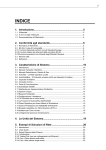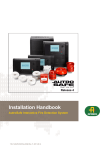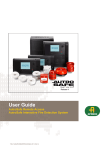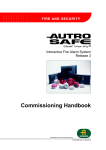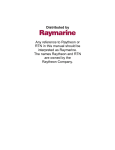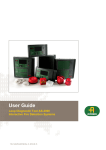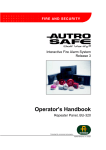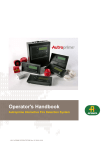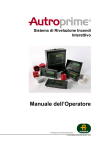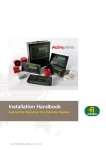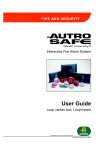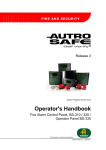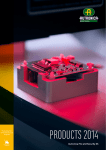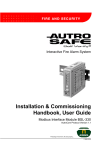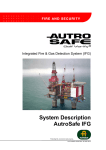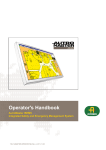Download Autronica AUTROSAFE 4 - User guide
Transcript
Release 4 Commissioning Handbook AutroSafe Interactive Fire Detection System 116-P-ASAFE-COMMISS/EGB Rev.D, 2011-09-14 COPYRIGHT © This publication, or parts thereof, may not be reproduced in any form, by any method, for any purpose. Autronica Fire and Security AS and its subsidaries assume no responsibility for any errors that may appear in the publication, or for damages arising from the information in it. No information in this publication should be regarded as a warranty made by Autronica Fire and Security. The information in this publication may be updated without notice. E-1676 Product names mentioned in this publication may be trademarks. They are used only for identification. This product contains static-sensitive devices. Avoid any electrostatic discharge. The WEEE Directive When the marking below is shown on the product and/or its literature, it means that the product should not be disposed with other household wastes at the end of its life cycle. During waste treatment, disposal and collection, please separate the product from other types of wastes and recycle it responsibly to promote the sustainable reuse of material resources. This product should not be mixed with other commercial wastes for disposal. Commissioning Handbook, AutroSafe Interactive Fire Detection System, Release 4, 116-P-ASAFE-COMMISS/EGB Rev.D, 2011-09-14, Autronica Fire and Security AS Page 2 Introduction Table of Contents 1. Introduction .......................................................................5 1.1 1.2 1.3 About the Handbook.......................................................................... 5 The Reader ....................................................................................... 5 Reference Documentation................................................................. 6 2. Quick Reference Guide ....................................................7 2.1 2.2 Initial Commissioning ........................................................................ 7 Upgrading System Software and Configuration ................................ 7 3. Verifying the Loops ..........................................................8 3.1 3.2 AS-2000 Loop Diagnostic Tool ......................................................... 8 Verification Procedure ....................................................................... 8 4. Consistency Check of Configuration Data .....................9 4.1 4.2 4.3 4.4 4.5 Introduction ........................................................................................ 9 Parameters Used for the Consistency Check ................................... 9 Importing Loop Data from the AS-2000 Tool .................................... 10 Consistency Check Using the AS-2000 / Config Mismatch Tool ..... 10 Generating Configuration Files ......................................................... 10 5. Power Commissioning .....................................................11 5.1 5.2 Addressing Power Boards on the AutroFieldBus .............................. 11 Switch Settings on Power Board BSF-400 ............................. 11 5.1.1 11 5.1.2 Location of Switches ............................................................... 11 5.1.3 AutroFieldBus Addresses ....................................................... 13 5.1.4 Power Board Configuration Switches ..................................... 14 Calibration Procedure - Power Unit BPS-410 ................................... 15 6. Addressing Panels ...........................................................16 6.1 6.2 6.3 6.4 Definitions .......................................................................................... 16 6.1.1 System ID................................................................................ 16 6.1.2 Panel ID .................................................................................. 16 Location of Switches ......................................................................... 17 Assigning System IDs ....................................................................... 18 Assigning Panel IDs .......................................................................... 19 7. Verifying the System Before Startup ..............................21 8. Startup Procedure ............................................................22 8.1 8.2 8.3 Applying Power to the System .......................................................... 22 IP Number Structure .......................................................................... 23 Assigning IP Adresses ...................................................................... 23 8.3.1 Automatic Addressing Mode ................................................... 24 8.3.2 Manual Addressing Mode ....................................................... 26 Commissioning Handbook, AutroSafe Interactive Fire Detection System, Release 4, 116-P-ASAFE-COMMISS/EGB Rev.D, 2011-09-14, Autronica Fire and Security AS Page 3 Introduction 8.4 8.5 8.6 8.7 8.3.3 Configuration Missing.............................................................. 27 Configuration File .............................................................................. 28 8.4.1 Name, Format and Extension ................................................. 28 8.4.2 Copying the Zip File to a USB Stick ........................................ 28 Uploading Configuration Files to the System .................................... 29 Configuration Mismatch..................................................................... 32 Entering Required Access Levels ..................................................... 33 9. Verifying the System after an Upload .............................35 9.1 9.2 General System Verification Procedure ............................................ 35 Verifying Detection Loops During Normal Operation ........................ 36 10. Upgrading the System ......................................................37 10.1 Introduction ........................................................................................ 37 10.2 Upgrading During Normal Operation (SW/Config) ............................ 37 10.2.1 Introduction ............................................................................. 37 10.2.2 Upgrading Software During Normal Operation ....................... 38 10.2.3 Upgrading Configuration During Normal Operation ................ 38 10.3 Upgrading when Panels are Added/Removed .................................. 39 10.4 Upgrading if IP Addresses are to be Changed.................................. 39 10.5 Upgrading a Single Panel.................................................................. 39 10.6 Upgrading by Remote Access to a Web site..................................... 40 10.7 Upgrading Software Version 4.0.1 to 4.1.1 ....................................... 41 10.7.1 General ................................................................................... 41 10.7.2 Preparing a System in Normal Operation ............................... 41 10.7.3 Preparing a System in System Fault Condition ...................... 42 10.8 Upgrading Software Version 4.0.1 or 4.1.1 to 4.3.1 .......................... 43 10.8.1 Example 1: Upgrading all Panels from SW Version 4.0.1 or 4.1.1 to 4.3.1 ...................................................................... 43 10.8.2 Example 2: Adding a BS-420/BS-430 panel with SW Version 4.1.1 to a System Running on SW Version 4.3.1 ...... 43 10.8.3 Example 3: Adding a BC-420 Controller with SW Version 4.1.1 to a System Running on SW Version 4.3.1 ................... 43 10.8.4 Example 4: Adding a Panel with SW Version 4.3.1 to a System Running on SW Version 4.1.1.................................... 44 11. Startup Procedure for a Dual Safety System .................45 11.1 Introduction ........................................................................................ 45 11.2 Guidelines – Startup Procedure ........................................................ 46 12. Fault Messages during Uploading ..................................48 12.1 12.2 12.3 12.4 12.5 Introduction ........................................................................................ 48 Invalid File on USB Stick ................................................................... 48 Data Transmission Timeout .............................................................. 48 Corrupt File ........................................................................................ 48 Fail to Unpack Files ........................................................................... 49 13. Reader’s Comments .........................................................51 Commissioning Handbook, AutroSafe Interactive Fire Detection System, Release 4, 116-P-ASAFE-COMMISS/EGB Rev.D, 2011-09-14, Autronica Fire and Security AS Page 4 Introduction E-1676 1. Introduction This product contains static-sensitive devices. Always use an antistatic wrist strap / ground bracelet to avoid any electrostatic discharge. 1.1 About the Handbook This handbook is intended to provide all necessary information for the commissioning of the AutroSafe Interactive Fire Detection System, Release 4. The handbook covers the commissioning of a standalone system (Fire Alarm Control Panel), as well as the commissioning of a distributed system with several system units, operating on Autronica’s local area network; AutroNet, including: Power Boards in Power Cabinet BP-405 and Power Unit BPS-405/BPS-410 (AutroFieldBus addressing) Fire Alarm Control Panel BS-420 Controller BC-420 Operating Panel BS-430 Repeater Panel BU-BV-420 1.2 The Reader The handbook is intended to be used by Autronica Fire and Security trained service and technical personnel who are responsible for the installation of the AutroSafe Interactive Fire Detection System, Release 4. Commissioning Handbook, AutroSafe Interactive Fire Detection System, Release 4, 116-P-ASAFE-COMMISS/EGB Rev.D, 2011-09-14, Autronica Fire and Security AS Page 5 Introduction 1.3 Reference Documentation The table below shows an overview of the technical marketing documentation for AutroSafe Interactive Fire Detection System, Release 4. Document Name System Description Installation Handbook Commissioning Handbook User Guide, Remote Access Connecting Loop Units Operator’s Handbook User Guide Wall Chart Menu Structure Datasheet; Fire Alarm Control Panel BS-420 Datasheet; Operator Panel BS-430 Datasheet; Repeater Panel BU-BV-420 Datasheet; Controller BC-420 Datasheet; Controller Unit Rack BC-440 Datasheet; Power Cabinet BP-405 Datasheet; Power Unit BPS-405 Datasheet; Power Unit BPS-410 Datasheet; AutroKeeper BN-180 Part number 116-P-ASAFE-SYSTEMD/EGB 116-P-ASAFE-INSTALL/DGB 116-P-ASAFE-COMMISS/EGB 116-P-ASAFE-REMOTEAC/EGB 116-P-CONNECTLOOPUNIT/DGB 116-P-ASAFE-OPERATE/FGB 116-P-ASAFE-USERGUI/LGB 116-P-ASAFE-WALLCHA/LGB 116-P-ASAFE-MENUSTR/MGB 116-P-BS420/CGB 116-P-BS430/CGB 116-P-BUBV420/CGB 116-P-BC420/CGB 116-P-BC440/CGB 116-P-BP405/CGB 116-P-BPS405/CGB 116-P-BPS410/CGB 116-P-BN180/CGB File name asafesystem_egb asafeinstall_dgb asafecommiss_egb asaferemoteac_egb connectloopunit_dgb asafeoperate_fgb asafeusergui_lgb asafewallcha_lgb asafemenustr_mgb bs420_cgb bs430_cgb bubv420_cgb bc420_cgb bc440_cgb bp405_cgb bps405_cgb bps410_cgb bn180_cgb Commissioning Handbook, AutroSafe Interactive Fire Detection System, Release 4, 116-P-ASAFE-COMMISS/EGB Rev.D, 2011-09-14, Autronica Fire and Security AS Page 6 Quick Reference Guide 2. Quick Reference Guide This quick reference guide outlines all the necessary steps to successfully commission the AutroSafe Interactive Fire Detection System the very first time, assuming that the system software is already uploaded to the system, and no configuration files have been uploaded. Configuration upgrade and system software upgrade are described in a separate chapter (Chapter 10). 2.1 Initial Commissioning Step Action Chapter 1 2 Verify the detection loops by means of the AS-2000 tool. Chapter 3 Perform a consistency check of the configuration data using the results from the AS-2000 verification and the data that has been configured by means of the AutroSafe Configuration Tool. Chapter 4 3 4 5 6 7 8 9 10 Assign an AutroFieldBus address to each Power Board BSF-400 (rotary switches) / AutroFieldBus unit. Chapter 5 Assign a System ID to each panel by means of rotary switches (on BSA-400). Chapter 6.3 Assign a Panel ID to each panel by means of switches (dipswitches and rotary switches on BSA-400). Chapter 6.3 Verify the system before startup Chapter 7 Apply power to the system Chapter 8.1 Assign an IP Address to each panel Chapter 8.3 Upload configuration data to all panels from one central point (a panel). Chapter 8.5 Verify the system after an upload Chapter 9 2.2 Upgrading System Software and Configuration For information regarding configuration upgrade and system software upgrade, refer to Chapter 10. Commissioning Handbook, AutroSafe Interactive Fire Detection System, Release 4, 116-P-ASAFE-COMMISS/EGB Rev.D, 2011-09-14, Autronica Fire and Security AS Page 7 Verifying the Loops 3. Verifying the Loops 3.1 AS-2000 Loop Diagnostic Tool All loops should be verified with the AS-2000 Loop Diagnostic Tool before startup. Although this is presumably already done at an earlier stage (shortly after the installation), it is recommended that all loops are verified once again in case minor changes have been done. By doing this, you will eliminate possible problems which could occur during the startup procedure and upgrading of configuration data. The AS-2000 allows you to find all points connected to the selected loop driver, and present them graphically. You will find detailed information on the installation and use of AS-2000 in the User Guide, AS-2000 Loop Diagnostic Tool. AS-2000 can be connected directly to an AutroSafe operating panel, or directly to a detection loop by means of an external interface unit, WAS-2000. 3.2 Verification Procedure Pressing the START button in the Topology window (AS-2000) tells AS-2000 to find all points connected to the selected loop driver, and present them graphically in a correct electrical sequence. Points will be presented with unique symbols for each type of Loop Unit, and with important information such as Production Number (PN), and the Loop Sequence Index (LSI). In case of illegal topologies, like multiple branch-offs and loop breaks, these will be presented with selfexplaining symbols. Use the AS-2000 to; register all loop units on each loop, including: the Loop Unit type (detector type, manual call point, electronic sounder, I/O unit) Loop Sequence Indexes LSI (order/location) register all branch offs and loop break positions locate any breaks on the loop wire (both positive and negative wires) measure the loops’ total resistance, current consumption and voltage drop earth fault Commissioning Handbook, AutroSafe Interactive Fire Detection System, Release 4, 116-P-ASAFE-COMMISS/EGB Rev.D, 2011-09-14, Autronica Fire and Security AS Page 8 Consistency Check of Configuration Data 4. Consistency Check of Configuration Data 4.1 Introduction NOTE: To ensure a problem-free upload of configuration data, always perform a consistency check, using the results from the AS-2000 verification and the data that has been configured by means of the AutroSafe Configuration Tool. 4.2 Parameters Used for the Consistency Check The table below provides a description of two of the parameters that are used for the consistency check. These parameters are shown in the Topology View in AS-2000, as well as in the topology view in the AutroSafe Configuration Tool. Parameter Abbreviation Description Illustration The loop unit can be a detector, a manual call point, a loop sounder or an I/O unit. Loop Unit (Examples) Heat detector (BD-200/300/500) Optical smoke detector (BH-200/300/500) MultiSensor detector (BH-220/320/520) Manual callpoint (BF-200/300/500) Electronic addressable sounder (BBR-200) Input / Output unit (BN-300, BN-310, BN-320 etc.) Loop Sequence Index LSI A loop specific index telling the exact Loop Unit order on the loop (sequencially numbered). A branch-off is described by a decimal followed by a sequencial index. (Example) 2.1 2.2 ALARM Fault FunctionDisabled Mute Panel FunctionDelayed Fire Brig. Signalled More Events Power Testing Fire Brig. Disabled Fire Brig. Fault SystemFault Alarms Disabled Alarms Fault Silence Alarms 1 Reset System 1 2 3 4 5 6 7 8 9 2 3 C 0 i 4 Autronica 11 5 5.1 Autronica 10 9 8 7 6 K NUS GLAS SE T TRY KK HE R P RES S HERE BREAK GLASS FARE Commissioning Handbook, AutroSafe Interactive Fire Detection System, Release 4, 116-P-ASAFE-COMMISS/EGB Rev.D, 2011-09-14, Autronica Fire and Security AS Page 9 Consistency Check of Configuration Data 4.3 Importing Loop Data from the AS-2000 Tool The AutroSafe Configuration Tool features an Import command allowing you to import loop data directly from the AS-2000 Loop Diagnostic tool. In this way, it is possible to ensure that the point types and sequence indexes in the configuration will be identical to the real loop. Tag Names and optional Detection Zones (DZs) will be assigned to the points during import. For further information, refer to the Help System for AutroSafe Configuration Tool and the User Guide for the AS-2000 Loop Diagnostic Tool. 4.4 Consistency Check Using the AS-2000 / Config Mismatch Tool The AutroSafe Configuration Tool allows you to do a consistency check of configuration data by means of a menu called AS-2000 / Config Mismatch Tool (in the Tool menu). This feature allows you to easily compare the actual configuration data downloaded from a detection loop and imported to the AutroSafe Configuration Tool (using the AS-2000) with the configuration data you have entered in the AutroSafe Configuration Tool. 4.5 Generating Configuration Files System configuration is done from a computer by the means of the AutroSafe Configuration Tool. This tool allows you to generate configuration files, which then can be uploaded to target after the system has been verified. Commissioning Handbook, AutroSafe Interactive Fire Detection System, Release 4, 116-P-ASAFE-COMMISS/EGB Rev.D, 2011-09-14, Autronica Fire and Security AS Page 10 Power Commissioning 5. Power Commissioning 5.1 Addressing Power Boards on the AutroFieldBus 5.1.1 Switch Settings on Power Board BSF-400 The board is configured by means of two switches: Rotary switches X10 and X11 - AutroFieldBus address switch. Each Power Board is given a unique address. Dipswitch S5/S6 – configuration (refer to dipswitch table, chapter 5.1.4) 5.1.2 Location of Switches The location of the dipswitch S5 and S6, plus the rotary switches X10 and X11 are shown on the drawing. Commissioning Handbook, AutroSafe Interactive Fire Detection System, Release 4, 116-P-ASAFE-COMMISS/EGB Rev.D, 2011-09-14, Autronica Fire and Security AS Page 11 Power Commissioning S5 1 2 AFB Earth Fault Off OFF OFF AFB Earth Fault On ON ON Dipswitch S5 J2 1 2 3 4 5 6 7 8 AFB A AFB A" AFB CT A AFB Earth Fault Sense AFB B AFB B" AFB CT B AFB Earth Fault Sense 1 1 2 3 4 5 6 6 A A R F F F F1 A1 + 0V J19 S1 Reset X10 Low B1 + 0V 8 7 6 5 4 3 2 1 X11 High A2 + 0V J18 J24 F2 S1 Reset button AutroFieldBus Address Switch X10, X11 A F3 B1 F2AL F4 B2 F2AL J23 B2 + 0V F5 C1 F2AL J22 C1 + 0V F6 C2 F2AL 1 1 2 3 4 5 6 Earth Fa Battery AFB pre Battery 6 ON J21 5 1 J17 F8 T10 AH T5 AH J20 F7 Battery Charger +24V Therm.+ Therm.PSF -V Vcon F7 BP-410/01 T10 AH BP-405/01 T5 AH F8 Charger C2 + 0V 5 4 3 2 1 Dipswitch S6 S6 OFF 1 BATT + - Commissioning Handbook, AutroSafe Interactive Fire Detection System, Release 4, 116-P-ASAFE-COMMISS/EGB Rev.D, 2011-09-14, Autronica Fire and Security AS Page 12 Power Commissioning 5.1.3 AutroFieldBus Addresses Each AutroFieldBus unit/Power Board BSF-400 on an AutroFieldBus must be assigned a unique address by means of an rotary switch (see previous page). The drawing below shows the AutroFieldBus connections on the main terminal block, list L1 mounted on a DIN rail inside the cabinet (BS-420/BC-420). The first AutroFieldBus unit is connected to the terminals L1.9 / L1.11 (AFB A). The last unit is connected to L1.3 / L1.5 (AFB B). Main terminal block, list L1 inside L1.3 L1.5 AFB Last AFB unit AFB First AFB unit L1.7 L1.9 L1.11 The first AutroFieldBus unit L1.13 L1.15 A maximum of 31 AutroFieldBus units can be connected to one AutroFieldBus, giving the number range 01 to 31. The illustration below shows an example of the system topology window. 4 AutroFieldBus units are added to the AutroFieldBus interface. The sequence of the units in the topology window determines the switch settings on each unit, i.e. the first unit (the uppermost unit in the topology window) is to be given switch address 01, the next is to be given switch address 02, and so on. Note that the physical sequence of AutroFieldBus units on the AutroFieldBus must not necessarily correspond to the sequence shown in the topology window, however this is recommended. Example: System topology window in the AutroSafe Configuration Tool Addressing AutroFieldBus units on the AutroFieldBus Fire Alarm Control Panel BS-420 BSA-400 Switch Address 01 Switch Address 04 BSD-321 BSF-400 Switch address 01 Switch address 02 Switch address 03 Switch address 04 AutroFieldBus BSF-400 Switch Address 02 BSF-400 Switch Address 03 Commissioning Handbook, AutroSafe Interactive Fire Detection System, Release 4, 116-P-ASAFE-COMMISS/EGB Rev.D, 2011-09-14, Autronica Fire and Security AS Page 13 Power Commissioning 5.1.4 Power Board Configuration Switches The settings of the dipswitches are read during startup. If the switches are changed for any reason, the changes will not take affect until the Power Board is restarted (pressing the reset button S1 on the Power Board). Dipswitch table – S5 S5.1 OFF ON S5.2 OFF ON Function AutroFieldBus earth fault OFF AutroFieldBus earth fault ON Dipswitch table – S6 Switch Name S6-1 Earth Fault S6-2 NA S6-3 AutroFieldBus S6-4 S6-5 NA Battery S6-6 Power Unit Type Comment ON: Earth fault monitoring activated OFF: Earth fault monitoring deactivated Must always be set to OFF (default). ON: AuttroFieldBus connected OFF: AutroFieldBus not connected ON: Battery connected OFF: Battery not connected ON: BPS-405 OFF: BPS-410 Commissioning Handbook, AutroSafe Interactive Fire Detection System, Release 4, 116-P-ASAFE-COMMISS/EGB Rev.D, 2011-09-14, Autronica Fire and Security AS Page 14 Power Commissioning 5.2 Calibration Procedure - Power Unit BPS-410 When using Power Unit BPS-410 (including a 24V/10A power supply), a calibration procedure must be performed. This is necessary in order to obtain a correct temperature compensated charging voltage to the batteries. The procedure is as follows: Before applying power to the system, the power supply’s temperature sensor (thermistor delivered with the power unit) must be temporarily replaced with a fixed 2,2k resistor (terminal point 2 and 6 from the left, marked with a stippled line from terminal point 2 to the thermistor symbol at point 6). Apply power to the system by connecting the mains cable to the mains socket or by switching the power ON from an external main fuse box. Measure the voltage on the BSF-400’s battery terminals (BATT +/-) while adjusting the voltage with a small screw driver to 27,4V on the power supply (OUT ADJ). AH AH BP-405/01 T5 T5 AH AH 1 J17 5 1 J20 BATT + +24V Therm.+ Therm.PSF -V Vcon arger 5 4 3 2 1 Measure - Adjust Disconnect mains power from the power supply and remove charger fuse F8. 1 J17 J20 F7 Battery Charger +24V 5 F8 T10 AH T5 AH F8 Charger 0V Therm.+ Therm.PSF -V Vcon C2 5 4 3 2 1 F7 BP-410/01 T10 AH BP-405/01 T5 AH Charger fuse F8 1 BATT + - Remove the resistor and reinsert the thermistor. Insert the charger fuse F8 and re-connect mains power to the power supply. Commissioning Handbook, AutroSafe Interactive Fire Detection System, Release 4, 116-P-ASAFE-COMMISS/EGB Rev.D, 2011-09-14, Autronica Fire and Security AS Page 15 Addressing Panels 6. Addressing Panels 6.1 Definitions 6.1.1 System ID A panel’s System ID indicates which system and unique configuration a panel belongs to. All panels communicating on the same AutroNet network must have the same System ID, usually set to 01 (switch setting; rotary switches X5 and X3). The System ID also determines the specific number series of the IP Addresses (which are set during commissioning by operating the AutroSafe menu). Note that the term “Network ID” is used on the circuit board’s label instead of the correct term System ID. In earlier AutroSafe 3 versions, Panel ID was used instead of System ID. 6.1.2 Panel ID Each panel in the system must be assigned a unique Panel ID which must correspond to the Panel ID given in the specific configuration in the Configuration Tool (switch setting; rotary switches X6 and X4, plus the settings of dip-switch S2). The Configuration Tool generates a catalogue structure with the following number series of Panel IDs for the different panel types: Panel Panel IDs Number Series BS-420 BC-420 BS-430 BU-420 BV-420 1-31 33-63 65-95 97-159 161-223 Panel IDs Hexadecimal values 01-1F 21–3F 41-5F 61-9F A1-DF Note that term System ID is used in the configuration tool and on the circuit board’s label instead of the correct term Panel ID. Commissioning Handbook, AutroSafe Interactive Fire Detection System, Release 4, 116-P-ASAFE-COMMISS/EGB Rev.D, 2011-09-14, Autronica Fire and Security AS Page 16 Addressing Panels 6.2 Location of Switches The switches are located on the lower left hand side of the BSA-400 circuit board, easily accessible through the hole in the metal cover. The BSA-400 circuit board X6 X4 X5 X3 S2 Commissioning Handbook, AutroSafe Interactive Fire Detection System, Release 4, 116-P-ASAFE-COMMISS/EGB Rev.D, 2011-09-14, Autronica Fire and Security AS Page 17 Addressing Panels 6.3 Assigning System IDs The settings of the rotary switches X5 and X3 determine the panel’s System ID, i.e. which system and unique configuration the panel belongs to. All panels communicating on the same AutroNet network must have the same System ID, usually set to 01. X5 is set to 0 X3 is set to 1 If there is a second network, this network can be set to 02, a third can be set to 03, etc. Switch X5 corresponds to the most significant digit in the address. X5 X3 Commissioning Handbook, AutroSafe Interactive Fire Detection System, Release 4, 116-P-ASAFE-COMMISS/EGB Rev.D, 2011-09-14, Autronica Fire and Security AS Page 18 Addressing Panels 6.4 Assigning Panel IDs The settings of the rotary switches X6 and X4, plus the settings of dipswitch S2 (type of panel) determine the Panel ID. Each panel in the system must be assigned a unique Panel ID (switch settings) which must correspond to the Panel ID given in the specific configuration in the Configuration Tool. Note that a standalone Fire Alarm Control Panel BS-420 always has Panel ID=00. Switch X6 corresponds to the most significant digit in the address. Note that the correct switch settings for the panel type in question is preset at the factory (dipswitch S2) - except for the BU-BV-420 panel, as this panel can be defined both as a Information Panel and Fire Brigade Panel. X6 X4 S2 The following table deals with the Panel IDs when several panels communicate on the AutroNet (local area network). Panel ID Hex. values Panel Panel ID BS-420 BC-420 BS-430 BU-420 BV-420 1-31 33-63 65-95 97-159 161-223 01-1F 21–3F 41-5F 61-9F A1-DF Panel Type Dip-switch S2 Rotary Rotary 0=OFF, 1=ON switch X6 switch X4 Switch 1 2 3 4 0-3 0-3 0-3 0-6 0-6 0-9 0-9 0-9 0-9 0-9 0000 1000 0100 1100 1010 Commissioning Handbook, AutroSafe Interactive Fire Detection System, Release 4, 116-P-ASAFE-COMMISS/EGB Rev.D, 2011-09-14, Autronica Fire and Security AS Page 19 Addressing Panels Example: A network configuration consists of two BS-420 panels, one BS-430 panel and one BU-BV-420 panel (a BU-BV-420 panel defined as a Fire Brigade Panel). In this example, the following addressing applies: Panel BS-420 BS-420 BS-430 BU-BV-420 Panel Type Dip-switch S2 Rotary Rotary 0=OFF, 1=ON Panel ID switch X6 switch X4 Switch 1 2 3 4 1 2 65 97 0 0 0 0 1 2 1 1 0000 0000 0100 1100 Commissioning Handbook, AutroSafe Interactive Fire Detection System, Release 4, 116-P-ASAFE-COMMISS/EGB Rev.D, 2011-09-14, Autronica Fire and Security AS Page 20 Verifying the System Before Startup 7. Verifying the System Before Startup Before verifying the system, all parts in all system units must be installed and properly connected, and all panels and AutroFieldBus units must be addressed correctly. Installation, cabling and connections Verify all internal cabling in all system units (all panels) Verify that all IO modules in the Fire Alarm Control Panel and Controller are installed in the cabinet Verify all external connections in the Fire Alarm Control Panel and Controller (to detector loops, other input / output connections) Addressing Verify that all AutroFieldBus units (Power Boards BSF-400) are addressed correctly Verify that all panels are assigned correct Panel IDs Verfiy that all panels are assigned System IDs Check power for correct mains voltage Commissioning Handbook, AutroSafe Interactive Fire Detection System, Release 4, 116-P-ASAFE-COMMISS/EGB Rev.D, 2011-09-14, Autronica Fire and Security AS Page 21 Startup Procedure 8. Startup Procedure When the AutroFieldBus units (Power Boards BSF-400 and all panels) have been addressed, and the configuration files have been generated by means of the AutroSafe Configuration Tool, power is to be applied to the system. The commissioning can take place from any Fire Alarm Control Panel BS-420 or Operator Panel BS-430 in the system (freely selected panel). During uploading of configuration files (or system software), the system may report possible faults. If such fault messages occur, the panel in question should be rebooted (Service Menu/Upgrade/Reboot). For detailed information on possible errors, refer to chapter 12, Fault Messages during Uploading. 8.1 Applying Power to the System Always connect the cables to the batteries first, then power up the system by connecting the mains cable to a mains socket (230V/115V AC) or by switching the power ON from an external main fuse box. When power is applied to the system the very first time, an initialization of the system will automatically take place. Apply power to the system. The display will show the following information (example): Autrosafe software version 4.3.1 Config model 4.4 Market version: Land Switch address 01-001 Searching for panels, found 2 of x BS-420 01.01: 4.3.1 BU-420 01.01: 4.3.1 IP not set, select addressing mode: 1. Automatic 2. Manual Note that, to prepare the system for later reconfigurations or software upgrades, a hardware reset must be performed. Refer to Upgrading the System, chapter 10. Commissioning Handbook, AutroSafe Interactive Fire Detection System, Release 4, 116-P-ASAFE-COMMISS/EGB Rev.D, 2011-09-14, Autronica Fire and Security AS Page 22 Startup Procedure 8.2 IP Number Structure Example: 172.16.101.21 172.17.101.117 172.16.101.21 Panel ID (+20), unique ID assigned to each panel System ID (+100), identifies which system and unique configuration the panel belongs to. Ethernet Port ID, referring to one of the two redundant network ports (each panel assigned to two consecutive numbers) Network Number, common number for all panels belonging to the same network 8.3 Assigning IP Adresses When the initialization is completed, the display will show the following: Autrosafe software version 4.3.1 Config model 4.4 Market version: Land Switch address 01-001 Searching for panels, found 2 BS-420 01.01: 4.3.1 BU-420 01.01: 4.3.1 IP not set, select addressing mode: 1. Automatic 2. Manual If Automatic Mode is selected, default IP Adresses will be assigned to each panel. The number series which is used depends on the switch settings for the panel’s System ID. Note: Use automatic addressing mode if you are not absolutely sure how to set IP addresses. Commissioning Handbook, AutroSafe Interactive Fire Detection System, Release 4, 116-P-ASAFE-COMMISS/EGB Rev.D, 2011-09-14, Autronica Fire and Security AS Page 23 Startup Procedure 8.3.1 Automatic Addressing Mode Selecting Automatic Addressing Mode will assign default IP Addresses to all panels. Autrosafe software version 4.3.1 Config model 4.4 Market version: Land Switch address 01-001 Searching for panels, found 2 BS-420 01.01: 4.3.1 BU-420 01.01: 4.3.1 IP not set, select addressing mode: 1. Automatic 2. Manual Press 1 to select Automatic Addressing. Autrosafe software version 4.3.1 Config model 4.4 Market version: Land Switch address 01-001 NETWORK ADDRESS: 172.16/172.17 BS-420 01.01: 101.21 BU-420 01.01: 101.117 Do you want to save or set manually? 1. Save 2. Set Address Manually When the automatic addressing is completed, you can either save the automatic addressing (proceed to next step), or set addresses manually (refer to chapter 8.3.2, Manual Addressing Mode). Commissioning Handbook, AutroSafe Interactive Fire Detection System, Release 4, 116-P-ASAFE-COMMISS/EGB Rev.D, 2011-09-14, Autronica Fire and Security AS Page 24 Startup Procedure To save the addressing, press 1. Autrosafe software version 4.3.1 Config model 4.4 Market version: Land Switch address 01-001 Searching for panels, found 2 BS-420 01.01: 4.3.1 BU-420 01.01: 4.3.1 Config missing Verify config on switch settings 3. Upgrade software 4. Upgrade config 6. Reboot panels When the IP addressing is completed, proceed to chapter 8.5, Uploading Configuration Files. Commissioning Handbook, AutroSafe Interactive Fire Detection System, Release 4, 116-P-ASAFE-COMMISS/EGB Rev.D, 2011-09-14, Autronica Fire and Security AS Page 25 Startup Procedure 8.3.2 Manual Addressing Mode If you have to take into consideration IP Addresses that are already assigned to other existing components on the network, IP Addresses can be set manually. In this way, you can freely select IP Addresses within the given ranges of 3 different number series, each representing a specific class (Class A, B or C). Note that the standard IP version 4 addressing is applied. This means that once a specific class is selected (A, B or C), only numbers within the range of this class can be selected. Class A: number series 1-127 Class B: number series 128-191 Class C: number series 192-223 Autrosafe software version 4.3.1 Config model 4.4 Market version: Land Switch address 01-001 IP ADDRESS: 172.16/172.17 BS-420 01.01: 101.21 BU-420 01.01: 101.117 Please set the SUB A network address: <10 . . . > <11 . . . > Set the network addresses If necessary, press 1 to change host address Press 2 to save the manual addressing When the manual IP addressing is completed, proceed to chapter 8.5, Uploading Configuration Files. Commissioning Handbook, AutroSafe Interactive Fire Detection System, Release 4, 116-P-ASAFE-COMMISS/EGB Rev.D, 2011-09-14, Autronica Fire and Security AS Page 26 Startup Procedure 8.3.3 Configuration Missing If no configuration has been uploaded to the system previously, the message “Config Missing” will be shown. Autrosafe software version 4.3.1 Config model 4.4 Market version: Land Switch address 01-001 Searching for panels, found 2 BS-420 01.01: 4.3.1 BU-420 01.01: 4.3.1 Config missing 1. Import config from USB stick 2. Reboot all panels Commissioning Handbook, AutroSafe Interactive Fire Detection System, Release 4, 116-P-ASAFE-COMMISS/EGB Rev.D, 2011-09-14, Autronica Fire and Security AS Page 27 Startup Procedure 8.4 Configuration File 8.4.1 Name, Format and Extension The AutroSafe Configuration Tool generates the following compressed file: AC_Vnn_mm_filename.tar.bz2 AC AutroSafeConfiguration Vnn Main interface model number mm Sub interface model number filename The AutroSafe configuration file name, valid characters are [0-9a-zA-Z] and underscore '_'. If the filename contains non-valid characters the file name will be replaced with the name "Configuration". The zip file cannot contain more than 127 characters, if so the filename will be truncated. 8.4.2 Copying the Zip File to a USB Stick Make sure to copy and paste the files in the root directory of the USB stick. Also make sure to remove all other files from the memory stick. When the configuration zip file is generated by means of the AutroSafe Configuration Tool, copy the file to a USB memory stick. Commissioning Handbook, AutroSafe Interactive Fire Detection System, Release 4, 116-P-ASAFE-COMMISS/EGB Rev.D, 2011-09-14, Autronica Fire and Security AS Page 28 Startup Procedure 8.5 Uploading Configuration Files to the System When the IP addressing is completed, configuration files can be uploaded to the system from one central point (any panel in the system). Autrosafe software version 4.3.1 Config model 4.4 Market version: Land Switch address 01-001 Searching for panels, found 2 BS-420 01.01: 4.3.1 BU-420 01.01: 4.3.1 Config missing Verify config on switch settings 3. Upgrade software 4. Upgrade config 6. Reboot panels Press 4 (Upgrade config). Autrosafe software version 4.3.1 Config model 4.4 Market version: Land Switch address 01-001 Searching for panels, found 2 BS-420 01.01: 4.3.1 BU-420 01.01: 4.3.1 Insert USB stick in USB port Insert the USB memory stick into one of the USB host ports on the BSA-400 Controller Board. Commissioning Handbook, AutroSafe Interactive Fire Detection System, Release 4, 116-P-ASAFE-COMMISS/EGB Rev.D, 2011-09-14, Autronica Fire and Security AS Page 29 Startup Procedure The following will appear on the display: Autrosafe software version 4.3.1 Config model 4.4 Market version: Land Switch address 01-001 Searching for panels, found 2 Transfering to panels (1 of 2) Autrosafe software version 4.3.1 Config model 4.4 Market version: Land Switch address 01-001 Searching for panels, found 2 Unpacking to panel (1 of 2) Please wait, upgrade in progress Autrosafe software version 4.3.1 Config model 4.4 Market version: Land Switch address 01-001 Searching for panels, found 2 Upgrading config… Finished 3. Upgrade software 4. Upgrade config 6. Reboot panels Remove the USB stick when the uploading is completed, then press 6 to reboot the system. Commissioning Handbook, AutroSafe Interactive Fire Detection System, Release 4, 116-P-ASAFE-COMMISS/EGB Rev.D, 2011-09-14, Autronica Fire and Security AS Page 30 Startup Procedure Selection 3. “Upgrade Software” is shown only if the software is not already upgraded. Autrosafe software version 4.3.1 Config model 4.4 Market version: Land Switch address 01-001 Searching for panels, found 2 Rebooting the system Please wait, upgrade in progress When the system is rebooted, the system will enter normal operation mode. To run initialization, press 1 or wait (countdown). Commissioning Handbook, AutroSafe Interactive Fire Detection System, Release 4, 116-P-ASAFE-COMMISS/EGB Rev.D, 2011-09-14, Autronica Fire and Security AS Page 31 Startup Procedure 8.6 Configuration Mismatch If the system has an existing configuration, and the new configuration you have uploaded does not match the installation in question, the message “Config Mismatch” will appear. If the software to be used is not supported by the config model, the message “Config Model Mismatch” will appear (see screenshot below). The “Config Faulty” message will appear if the configuration files for some reason are corrupt. The “Config Market Mismatch” message will appear if the panel does not match the market that has been selected in the configuration. Autrosafe software version 4.3.1 Config model 4.4 Market version: Land Switch address 01-001 Searching for panels, found 2 BS-420 01.01: 4.3.1 BU-420 01.01: 4.3.1 Config model mismatch Verify Config 3. Upgrade software 4. Upgrade config 6. Reboot panels Commissioning Handbook, AutroSafe Interactive Fire Detection System, Release 4, 116-P-ASAFE-COMMISS/EGB Rev.D, 2011-09-14, Autronica Fire and Security AS Page 32 Startup Procedure 8.7 Entering Required Access Levels All user interface controls are classified as belonging to one of the different access levels described below: Access Level Access Remedy 1 No key or password required. Accessible by members of the general public. All mandatory indications are visible at access level 1 without prior manual intervention. Description 2 Access by key. Accessible by persons having a specified responsibility for safety. 3 Password restricted. Accessible by persons trained and authorized to do reconfiguration of site specific data and maintenance according to the manufacturer’s published instruction. To be able to verify the system after an upgrade, Access Level 2 must be entered. Access Level 2 is accessed by the key (turn the key counter-clockwise). Access level 3 is entered as described in the procedure below. Step Actions to be taken 1 To enter the Main Menu from normal Operation Mode, press Display Indication MAIN MENU 19:23 1 SHOW STATUS 2 DISABLE 3 ENABLE 4 SYSTEM 5 SERVICE 6 OUTPUT CONTROL 2 To select SYSTEM, press 4. SYSTEM 19:23 1 DATE AND TIME 2 INFORMATION 3 ACCESS LEVEL 3 4 PRINTER 5 CHANGE LANGUAGE 6 INITIALIZE 7 DAY/NIGHT TIMERS Commissioning Handbook, AutroSafe Interactive Fire Detection System, Release 4, 116-P-ASAFE-COMMISS/EGB Rev.D, 2011-09-14, Autronica Fire and Security AS Page 33 Startup Procedure Step 3 Actions to be taken Display Indication To select ACCESS LEVEL 3, press 3. SYSTEM 19:23 ACCESS LEVEL 3 1 ENTER ACCESS LEVEL 3 2 LEAVE ACCESS LEVEL 3 3 SET PASSWORD 4 To enter ACCESS LEVEL 3, press 1. SYSTEM 19:23 ACCESS LEVEL 3/ENTER ACCESS LEVEL 3 Enter password: 5 Enter the password, then press SYSTEM 19:23 ACCESS LEVEL 3/ENTER ACCESS LEVEL 3 twice. Enter password: **** Successfully Completed Commissioning Handbook, AutroSafe Interactive Fire Detection System, Release 4, 116-P-ASAFE-COMMISS/EGB Rev.D, 2011-09-14, Autronica Fire and Security AS Page 34 Verifying the System after an Upload 9. Verifying the System after an Upload 9.1 General System Verification Procedure To ensure that the system works properly during normal operation after an upload, the whole system (control panel, detectors, control functions) should be verified after an upload. Step Description 1 To test the panel indicator lights and internal buzzer, press and hold the Reset button for at least 5 seconds. All indicators are lit and the buzzer is turned on. The test will automatically stop. The lamp test can be performed in access level 1 (no use of key). 2 Test all operating keys by pressing each key (refer also to Operator’s Handbook): All buttons will give a short "Beep" when pressed except Mute button, Menu button and Reset System button (plus the ones that are not supported, see below). Mute Panel button Silence Alarms button Reset System button Menu button Close Window button Alphanumeric keyboard Manoeuvre buttons Note that the left/right arrow buttons and the two buttons in the lowermost right hand corner (indicated with a white line) are not yet supported: ‘ 3 4 5 Perform a visual and functional inspection of manual call-points and automatic detectors. 6 7 Test all control functions. Disable any alarm transference to the Fire Alarm Routing Equipment -FARE output. Activate the alarm system. Test all sounders by activating an alarm from a corresponding manual call-point. Activate alarms from at least one detector/manual call-point in each zone and a check that Commissioning Handbook, AutroSafe Interactive Fire Detection System, Release 4, 116-P-ASAFE-COMMISS/EGB Rev.D, 2011-09-14, Autronica Fire and Security AS Page 35 Verifying the System after an Upload Step Description all respective outputs are activated. 8 Test the action of any auxiliary operating functions (disabling, cancelling and resetting buttons). 9 Check the alarm transference outputs by connecting from outgoing outputs (potential free relay and 24V output) activated by alarm in a zone. 10 Check the fault warning function from detector zones by removing a detector in each zone. Activate a fault (remove battery fuse) and observe: - the Fault indicator starts to blink - a fault warning is displayed - the internal buzzer is turned ON - the Fault Warning Routing Equipment (FWRE) output is activated (if any) 11 Verify all conditions, i.e.: - Fire Alarm condition - Fire Warning condition - Fault Warning condition - Disablement condition - Test condition 12 On completion of checks, ensure that only the green "Power" indicator is ON when the panel is in its idle state (normal operation). 13 Enable alarm transference to the Fire Alarm Routing Equipment -FARE output. 9.2 Verifying Detection Loops During Normal Operation It may be necessary to verify the detection loops (checking the loop topology, the types of loop units, the location of loop units, the Loop Sequence Indexes, etc.) during normal operation using the AS-2000 Loop Diagnostic Tool. Before applying the tool, prepare the system for the verification as follows: Enter the Service Menu (5), select Upgrade (5), then Reboot System (6). The system will now enter system fault condition. Power Board BSF-400 Remove fuse A1 and A2 from the Power Board BSF-400. Connect and apply the tool, and do the necessary verifications. S5 1 2 AFB Earth Fault Off OFF OFF AFB Earth Fault On ON ON 1 2 3 4 5 6 7 8 J2 AFB A AFB A" AFB CT A AFB Earth Fault Sens AFB B AFB B" AFB CT B AFB Earth Fault Sens A1 + 0V S X11 High J18 X10 Low B + A2 + 0V J24 J19 Fuse A1 and A2 Alternative 1: Disconnect a detection loop. Use the AS-2000 Was-box to verify the loop. Perform a verification for each loop in turn. Alternative 2: Disconnect the ribbon cable to BSL-310. Connect the AS-2000. Run an initialization. When the verification is completed, disconnect the tool/PC, reconnect the cables, then re-place the fuses. Reboot the system again. Commissioning Handbook, AutroSafe Interactive Fire Detection System, Release 4, 116-P-ASAFE-COMMISS/EGB Rev.D, 2011-09-14, Autronica Fire and Security AS Page 36 10. Upgrading the System 10.1 Introduction NOTE: When upgrading the system by means of a USB memory stick, do not remove the USB stick from the USB port until you are sure that the upgrade procedure is completed. Enter the menu “View Upgrade Status” to follow the progress and verify that the procedure is completed. After the very first startup of a system, a running system can be upgraded at any time using the service menu commands (shown in the next chapter). The upgrading can be performed from any Fire Alarm Control Panel BS-420 or Operator Panel BS-430 in the system (a freely selected panel). Note that once you have selected a “master” panel for upgrading, the system will temporarily block all other panels during the upgrade procedure, preventing the system from being upgraded from other panels. This chapter deals with upgrading by means of a USB memory stick. Upgrading can also be performed by using a computer remotely connected to a web site (refer to separate handbook). 10.2 Upgrading During Normal Operation (SW/Config) 10.2.1 Introduction The Service Menu includes submenus which allows you to upgrade both the system software and the configuration (or either of them) during normal operation (see following chapters). Note that if both the software and the configuration are to be upgraded, the system software and configuration have to be supported by the same config model. As a general rule, if both the software and the configuration are to be upgraded, always upgrade the software version first, then the configuration. To use the Service Commands, access level 3 is required (refer to Operator’s Handbook). Upgrade Upgrade SW Upgrade Config Export Config Export Log View Upgrade Status Reboot System After an upgrade, a reboot must always be executed for changes to take effect (software and/or configuration ugrade). Note that it is possible to upgrade both software and the configuration in turn before rebooting, i.e. it is not necessary to reboot after each single upgrade. Commissioning Handbook, AutroSafe Interactive Fire Detection System, Release 4, 116-P-ASAFE-COMMISS/EGB Rev.D, 2011-09-14, Autronica Fire and Security AS Page 37 Upgrading the System 10.2.2 Upgrading Software During Normal Operation Note that before executing this command, insert the USB memory stick with the correct and valid file into one of the USB ports on the BSA-400 Controller Board. After the stick is inserted, wait at least 5 seconds before executing the command. From the panel front, press 5 to enter the Service Menu (Access Level 3). To select Upgrade, press 5. To Upgrade SW press 1. To view the upgrade status, the View Upgrade Status command can be used. If you do not intend to upgrade the configuration at this point, the panel has to be rebooted for changes to take effect. If you also intend to upgrade the configuration, do not reboot at this point, but go to Upgrade Config (see next chapter). When the upgrade is completed, press 6 to run the Reboot System command. NOTE: Do not remove the USB stick from the USB port until you are sure that the upgrade procedure is completed. 10.2.3 Upgrading Configuration During Normal Operation Note that before executing this command, insert the USB memory stick with the correct and valid file into one of the USB ports on the BSA-400 Controller Board. After the stick is inserted, wait at least 5 seconds before executing the command. From the panel front, press 5 to enter the Service Menu (Access Level 3). To select Upgrade, press 5. To Upgrade Config press 2. To view the upgrade status, the View Upgrade Status command can be used. If you do not intend to upgrade the software at this point (if not already done), the panel has to be rebooted for changes to take effect. If you also intend to upgrade the software (supported by the same config model), do not reboot at this point, but go to Upgrade Software (see previous chapter). When the upgrade is completed, press 6 to run the Reboot System command,. NOTE: Do not remove the USB stick from the USB port until you are sure that the upgrade procedure is completed. Commissioning Handbook, AutroSafe Interactive Fire Detection System, Release 4, 116-P-ASAFE-COMMISS/EGB Rev.D, 2011-09-14, Autronica Fire and Security AS Page 38 Upgrading the System 10.3 Upgrading when Panels are Added/Removed If panels are added or removed, or it is necessary to change IP addresses, a reboot must be executed. The continuing procedure is similar to the startup procedure, chapter 8. Go to chapter 8 and follow the procedure. 10.4 Upgrading if IP Addresses are to be Changed If it is necessary to change IP addresses, a reboot must be executed. The continuing procedure is described in the startup procedure, chapter 8. Go to chapter 8 and follow the procedure. 10.5 Upgrading a Single Panel If a single panel in a network system for some reason has a wrong software and/or configuration version, the process of upgrading the entire system could be both unnecessarily time-consuming, or even impossible if the software versions are incompatible. To simplify the version correction in such a case, the system features an upgrade procedure of a single panel. Before the upgrade procedure is carried out, the file name of the software and/or configuration file has to be changed. NOTE: Do not remove the USB stick from the USB port until you are sure that the upgrade procedure is completed. Locate the software/configuration file(s) in question on your computer. Change the name of the software file: Add the text _Recovery to the name of the software file as follows: Example: The file name AS_V4_3_0_0_C4_34.tar.bz2 is changed to AS_V4_3_0_0_C4_34_Recovery.tar.bz2 Change the name of the configuration file: Remove the text representing the “file name” (in this example, Tiller) and replace it with the text Recovery: Example; AC_4_34_Tiller.tar.bz2 is changed to AC_4_34_Recovery.tar.bz2 Copy the file(s) onto your USB memory stick. Insert the USB memory stick into one of the USB ports on the BSA-400 Controller Board, then reboot the panel. The panel will automatically be upgraded. If the panel has a display, the process similar to the startup procedure will be shown (chapter 8). If the panel does not have a display, the process will be indicated by means of the yellow LED indicator D2 on the BSA-400 board as follows (see illustration, chapter 10.7.3): - Slow blink: upgrade in progress - Fast blink: upgrade failed - Steady yellow light: Upgrade completed, remove stick to reboot the panel Commissioning Handbook, AutroSafe Interactive Fire Detection System, Release 4, 116-P-ASAFE-COMMISS/EGB Rev.D, 2011-09-14, Autronica Fire and Security AS Page 39 Upgrading the System 10.6 Upgrading by Remote Access to a Web site Upgrading can be performed by means of a computer with remote access to a web site providing several service functions. From the Service menu, press 6 to select Remote Access. For further information, refer to separate handbook. Commissioning Handbook, AutroSafe Interactive Fire Detection System, Release 4, 116-P-ASAFE-COMMISS/EGB Rev.D, 2011-09-14, Autronica Fire and Security AS Page 40 Upgrading the System 10.7 Upgrading Software Version 4.0.1 to 4.1.1 10.7.1 General This chapter deals with the upgrade from software version 4.0.1 to 4.1.1. IMPORTANT: Follow the upgrade procedure as described in detail below. During the upgrade to software version 4.1.1, the system will enter system fault condition. Do NOT disconnect the mains power or press the front panel’s Reset System button. Press the front panel’s Mute button to silence the buzzer. Note that a panel that has been upgraded to software version 4.1.1 cannot be downgraded to software version 4.0.1. Before reconfiguring the system or upgrading the system software, a hardware reset must be executed. All panels belonging to the same system will be reset and upgrading can then take place. If the system is in normal operation, go to chapter 10.7.2. If the system is in system fault condition, go to chapter 10.7.3. 10.7.2 Preparing a System in Normal Operation Push the reset button S5 less than 1 second to shut down the panel in a controlled manner. Wait until the blue LED indicator D22 (see illustration on next page) goes off. The panel has now entered system fault condition. Go to chapter 10.7.3. Commissioning Handbook, AutroSafe Interactive Fire Detection System, Release 4, 116-P-ASAFE-COMMISS/EGB Rev.D, 2011-09-14, Autronica Fire and Security AS Page 41 Upgrading the System 10.7.3 Preparing a System in System Fault Condition To perform a hard reset, push and hold down the reset button S5 until the red LED indicator D20 and D21 are lit for a short moment and you hear a click from the relay. Reset button S5 Controller Board BSA-400 LEDs D20 D21 D13 D17 D3 D23 D2 D18 D15 D22 D1 D19 D16 LEDs The system will now detect all running panels, and prompt you to reboot the entire system (all running panels). Verify that all panels in the system are detected. Press 2 to select Reboot running panels. When all panels are rebooted, four selections will appear. Press 3 (“Upgrade Software”). Insert the USB memory stick with the valid file into one of the USB host ports on the BSA-400 Controller Board. The display will indicate when the uploading is completed. Remove the USB stick. The system will automatically reboot. After a short while, the panel will indicate system fault condition. Do NOT disconnect the mains power or press the front panel’s Reset System button. Press the front panel’s Mute button to silence the buzzer. When the system is rebooted, the system will be upgraded (the new system software version) and the system will enter normal operation mode. Proceed with the upgrading procedure. Commissioning Handbook, AutroSafe Interactive Fire Detection System, Release 4, 116-P-ASAFE-COMMISS/EGB Rev.D, 2011-09-14, Autronica Fire and Security AS Page 42 Upgrading the System 10.8 Upgrading Software Version 4.0.1 or 4.1.1 to 4.3.1 This chapter shows examples of how to upgrade from software version 4.0.1 or 4.1.1 to 4.3.1. 10.8.1 Example 1: Upgrading all Panels from SW Version 4.0.1 or 4.1.1 to 4.3.1 All panels have software version 4.0.1 or 4.1.1 installed. Upgrade all panels simultaneously by using a USB stick including program version 4.3.1 (or later when available). 10.8.2 Example 2: Adding a BS-420/BS-430 panel with SW Version 4.1.1 to a System Running on SW Version 4.3.1 A system is running on software version 4.3.1. A new BS-420/BS-430 panel with software version 4.1.1 installed is going to be added. Start the new panel without connecting it to the AutroNet. Install version 4.3.1 by using an USB stick. Connect the new panel to the system AutroNet. Restart the system and upgrade the new system configuration data by using an USB stick. 10.8.3 Example 3: Adding a BC-420 Controller with SW Version 4.1.1 to a System Running on SW Version 4.3.1 A system is running with software version 4.3.1. A new BC-420 Controller with software version 4.1.1 installed is going to be added. Disconnect a BS-420 panel from the system AutroNet. Restart and downgrade the BS-420 panel to run version 4.1.1 by using a USB stick. Temporarily, connect the downgraded panel and the new BC-420 Controller together by using an AutroNet connection. Start the two system units and upgrade them to run version 4.3.1 by using an USB stick. Connect the two system units to the original system AutroNet. Restart the system and upgrade the new system configuration data by using an USB stick. Commissioning Handbook, AutroSafe Interactive Fire Detection System, Release 4, 116-P-ASAFE-COMMISS/EGB Rev.D, 2011-09-14, Autronica Fire and Security AS Page 43 10.8.4 Example 4: Adding a Panel with SW Version 4.3.1 to a System Running on SW Version 4.1.1 A system is running on software version 4.1.1. A new panel with software version 4.3.1 installed is going to be added. Start the system without connecting the new panel to the AutroNet. Upgrade the system to run version 4.3.1 by using a USB stick. Connect the new panel to the system AutroNet. Restart the system and upgrade the new system configuration data by using an USB stick. Commissioning Handbook, AutroSafe Interactive Fire Detection System, Release 4, 116-P-ASAFE-COMMISS/EGB Rev.D, 2011-09-14, Autronica Fire and Security AS Page 44 Startup Procedure for a Dual Safety System 11. Startup Procedure for a Dual Safety System 11.1 Introduction This chapter describes the initial startup procedure of a system consisting of a Primary System and a Secondary System (AutroSafe Dual Safety concept). In principle, the startup procedure is identical to the startup procedure of a normal system, however, the startup procedure must be carried out for each system in turn (both the Primary System and the Secondary System). The startup of the Primary System can take place from any selected Fire Alarm Control Panel BS-420 or Operator Panel BS-430 belonging to the Primary System. Likewise, the startup of a Secondary System can take place from any panel belonging to the Secondary System. There are two AutroKeepers BN-180 for each detection loop in a Dual Safety System. One must be assigned to the Primary System and the other to the Secondary System (dipswitch settings). Furthermore, the type of protocol for the AutroFieldBus Protocol Converter BSD-321 (if used) must be set to Al_Com+ (rotary switch setting). In the following guidelines, a startup of the Secondary System is carried out first, then the Primary System. When the startup of both systems is completed, the Primary System will be in Active Mode (it controls the detecton loops), and the Secondary System will be in Standby Mode (ready to take over control of the detection loops). Commissioning Handbook, AutroSafe Interactive Fire Detection System, Release 4, 116-P-ASAFE-COMMISS/EGB Rev.D, 2011-09-14, Autronica Fire and Security AS Page 45 Startup Procedure for a Dual Safety System 11.2 Guidelines – Startup Procedure The following guidelines apply: Step Action Chapter 1 Perform the following actions for both the Primary and the Secondary System: Verify the detection loops by means of the AS-2000 tool. Perform a consistency check of the configuration data using the results from the AS-2000 verification and the data that has been configured by means of the AutroSafe Configuration Tool. Assign an AutroFieldBus address to each AutroFieldBus unit. Assign a Panel ID to each panel by means of switches (dip-switches and rotary switches on BSA-400). Assign a System ID to each panel by means of rotary switches (on BSA-400). Verify the system before startup (chapter 7). 3, 4, 5, 6 and 7. 2 Define the type of protocol and assign an AutroFieldBus address on the AutroFieldBus Protocol Converter BSD-321 The BSD-321’s default protocol by delivery is Al_Com+. If needed, the procedure for selecting the protocol type is described below. Set the actual AutroFieldBus address in the range of 1-31 according to the specific configuration. The type of protocol is defined by on-board rotary switches. To select protocol type: Apply power to the converter. Set the switches to 70 (Al_Com+), then press the reset button. The indicators will start flashing. When the indicators stop flashing after a short while. Set the actual AutroFieldBus address, then press reset. BCD BCD HIGH LOW 901 ON ON 1234567 1234567 ST1 RX AFB: TX 901 RX0 TX0 RX1 TX1 ST0 FLT. PWR 78 3 23 456 S1 456 23 Address switches 78 Reset switch S2 Set switches for Primary or Secondary on the AutroKeepers (BN-180) Set dipswitch 1 in postion OFF for the BN-180 that belongs to the Primary System Set dipswitch 1 in postion ON for the BN-180 that belongs to the Secondary System Apply power to BN-180 (24V DV external power). Commissioning Handbook, AutroSafe Interactive Fire Detection System, Release 4, 116-P-ASAFE-COMMISS/EGB Rev.D, 2011-09-14, Autronica Fire and Security AS Page 46 Startup Procedure for a Dual Safety System Step Action Chapter 4 Apply power to the panel belonging to the Secondary System, then: Select Automatic addressing mode to assign an IP Address to each panel. Upload configuration data to all panels from the panel in question. Start system, perform an initialization. 8.1, 8.3, 8.5 5 Apply power to the panel belonging to the Primary System, then: Select Automatic addressing mode to assign an IP Address to each panel. Upload configuration data to all panels from the panel in question. Start system, perform an initialization. 8.1, 8.3, 8.5 6 Verify the Dual Safety functionality: The Primary System is now in Active Mode. The Secondary System is in Standby Mode (the indicator Dual Safety Stdby on this panel has a steady yellow light). Perform a manual transfer of control from the Primary System to the Secondary System. From the Primary System, enter the Service Menu, and select Dual Safety, then Transfer to Secondary As soon as the loop control is transferred to the Secondary System, the indicator Dual Safety Stdby will be lit on the Primary System’s panel and will go off on the Secondary System’s panel. 7 Transfer the control back to the Primary System From the Primary System, enter the Service Menu, and select Dual Safety, then Transfer to Primary As soon as the loop control is transferred to the Primary System, the indicator Dual Safety Stdby will be lit on the Secondary System’s panel. 8 Verify the entire system after an upload. 9 Dual Safety Stdby Applicable to systems using the Dual Safety concept; a system with redundant loop control consisting of a Primary and Secondary System. Steady yellow light: The panel is in Standby Mode, i.e. this panel does not control the detection loops. The panel(s) in the other system controls the detection loops and is in Active Mode. Blinking light: the panel does not control all detection loops/loop units, and/or loop control is being transferred. Actions must be taken. Commissioning Handbook, AutroSafe Interactive Fire Detection System, Release 4, 116-P-ASAFE-COMMISS/EGB Rev.D, 2011-09-14, Autronica Fire and Security AS Page 47 Fault Messages during Uploading 12. Fault Messages during Uploading 12.1 Introduction During uploading, the system may report possible faults. If such fault messages occur, the panel in question should be rebooted by means of the reset button S5 on the Controller Board BSA-400 inside the panel. To perform a hard reset, push and hold down the reset button S5 (approximately 6 to10 seconds) until the red LED indicators D20 and D21 are lit for a short moment and you hear a click from the relay. 12.2 Invalid File on USB Stick Invalid file is found on the USB stick Example: Software: "Software Upgrade, File with syntax AS_V*_*_*_*_C*_*.tar.bz2 not found in root folder" Config: "Config Upgrade, File with syntax AC_V4_5_*.tar.bz2 not found in root folder" 12.3 Data Transmission Timeout The transmission of data to a panel takes too long (timer) due to a possible network failure: "Transfer to panel <NN> timed out" 12.4 Corrupt File File found, but it is corrupt (crc). Example: "Corrupt file AS_V4_0_0_1_C4_5.tar.bz2" Commissioning Handbook, AutroSafe Interactive Fire Detection System, Release 4, 116-P-ASAFE-COMMISS/EGB Rev.D, 2011-09-14, Autronica Fire and Security AS Page 48 Fault Messages during Uploading 12.5 Fail to Unpack Files If the unpacking of files on a panel is not successful, one of the following error messages may occur: "Failed to unpack, file system error on panel <NN>" "Failed to unpack, panel error on panel <NN>" Commissioning Handbook, AutroSafe Interactive Fire Detection System, Release 4, 116-P-ASAFE-COMMISS/EGB Rev.D, 2011-09-14, Autronica Fire and Security AS Page 49 Reader’s Comments . Reader’s Comments Please help us to improve the quality of our documentation by returning your comments on this manual: Title: Commissioning Handbook, AutroSafe Interactive Fire Detection System, Release 4, Ref. No.: 116-P-ASAFE-COMMISS/EGB Rev.D, 2011-09-14 Your information on any inaccuracies or omissions (with page reference): Please turn the page Commissioning Handbook, AutroSafe Interactive Fire Detection System, Release 4, 116-P-ASAFE-COMMISS/EGB Rev.D, 2011-09-14, Autronica Fire and Security AS Reader’s Comments Suggestions for improvements Thank you! We will investigate your comments promptly. Would you like a written reply? Yes No Name: ------------------------------------------------------------------------------------------------ Title: ------------------------------------------------------------------------------------------------ Company: ------------------------------------------------------------------------------------------------ Address: ---------------------------------------------------------------------------------------------------------------------------------------------------------------------------------------------------------------------------------------------------------------------------------------------- Telephone: ------------------------------------------------------------------------------------------------ Fax: ------------------------------------------------------------------------------------------------ Date: ------------------------------------------------------------------------------------------------ Please send this form to: Autronica Fire and Security AS N-7483 Trondheim Norway Tel: + 47 73 58 25 00 Fax: + 47 73 58 25 01 www.autronicafire.com Commissioning Handbook, AutroSafe Interactive Fire Detection System, Release 4, 116-P-ASAFE-COMMISS/EGB Rev.D, 2011-09-14, Autronica Fire and Security AS Autronica Fire and Security is an international company, headquartered in Trondheim, one of the largest cities in Norway. The company is owned by United Technologies Corporation and employs more than 319 persons with experience in developing, manufacturing and marketing of fire safety equipment. Our products cover a broad range of systems for integrated solutions, including fire detection systems, integrated fire and gas detection systems, control and presentation systems, voice alarm systems, public address systems, emergency light systems, plus suppression systems. All products are easily adaptable to a wide variety of applications, among others, hospitals, airports, churches and schools, as well as to heavy industry and high-risk applications such as power plants, computer sites and offshore installations, world wide. The company's strategy and philosophy is plainly manifested in the business idea: Protecting life, environment and property. Quality Assurance Stringent control throughout Autronica Fire and Security assures the excellence of our products and services. Our products are CE marked and developed for worldwide standards and regulations, and conform to the CEN regulation EN54. Our quality system conforms to the Quality System Standard NS-EN ISO 9001:2000 and is valid for the following product and service ranges: marketing, sales, development, engineering, manufacture, installation, commissioning and servicing of suppression, integrated fire and gas detection and alarm systems, plus petrochemical, oil and gas instrumentation systems for monitoring and control. Autronica Fire and Security AS Headquarters, Trondheim, Norway. Phone: + 47 73 58 25 00, fax: + 47 73 58 25 01. Head Office Oil & Gas, Stavanger, Norway. Phone: + 47 51 84 09 00, fax: + 47 51 84 09 99. Division Oil & Gas, Oslo, Norway. Phone: + 47 23 17 50 50, Fax: + 47 23 17 50 51 Division Oil & Gas, PO Box 416, Farnborough GU14 4AT, UK. Phone: + 47 51 84 09 00, Fax: + 44 84 52 80 20 55 Division Maritime, Suppression/New Build Detection & Alarm. Norway. Phone: + 47 31 29 55 00, Fax: + 47 31 29 55 01 Division Maritime, After Sales/Service Detection & Alarm, Norway. Phone: +47-73 58 25 00, Fax: +47-73 58 25 01 Visit Autronica Fire and Security's Web site: www.autronicafire.com






















































